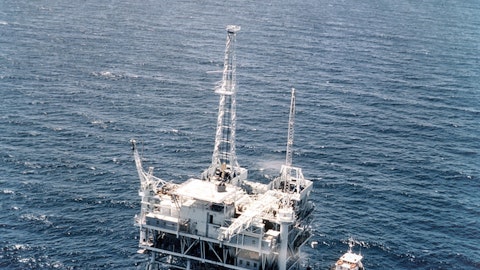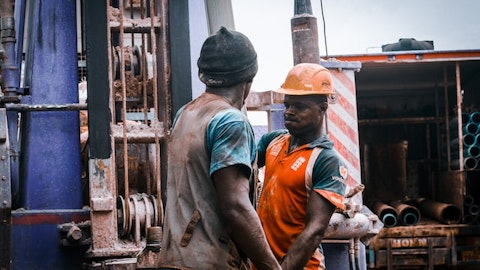Patrick Schorn: No, that is fair, Greg. So let me say a few things, although I’ll leave the lion’s share of this for Bruno. So the way that it looks at this moment, one of the rigs will potentially, 2, maybe 3 months be available for service in 2024. The second one is only going to be really available to drill, call it, January 25. And I think that what we were talking about seeing the additional demand of 24 to 25 rigs from our perspective, there is some interesting term work in that. And for us, it is really a matter that we want to see that these rigs get on some interesting contracts that have a bit of longevity in them. So term in this is important. But Bruno, maybe you can talk a little bit more about what you’re seeing and where we’re focused on, and I guess that people are quite interested, when we would be interested in committing to award any work to these.
Bruno Morand: Thanks, Patrick. Yes, Greg, and we mentioned a little bit in the last quarter. These rigs that are being delivered late in the year are probably some of the most capable rigs that we have in our fleet. And because of the prior track record success of the sister rigs operating in Asia, they have been attracting substantial interest from customers, particularly ones that are very performance focused. Obviously, taking a rig out of the yard and everything that comes with it is not a small commitment. We’re looking preferably to find work that has volume and volume, I would say, programs that are 18 months plus, ideally to take them out of the yard. We’re not concerned, obviously, about them finding continued work, but I think it’s obviously preferable if we can find a good balance between attractive day rates and a term that makes it easy for us to phase the rig into work.
Greg Lewis: And then I guess, just really, given that you provided some great detail on the Indian market, realizing that’s not a primary market for you guys and just because it’s timely around the decisions by Saudi Arabia last year in January around reining in some CapEx. Clearly, Saudi Arabia is a huge market. I can go and look at the 80-plus rigs there and look at different ages and quality of rig. Do you have any sense for maybe as we look at Saudi Arabia, how we think — how we could see maybe some rigs kind of move out of there and where they could go or is it something where a lot of those rigs are kind of nearing their useful life and maybe some of those rigs in Saudi probably aren’t working in 3 years to 5 years?
Patrick Schorn: No. I think, Greg, it is a question. Clearly, Saudi is a tremendously large market that does govern what happens in the rest of the world. So I mean all I can tell you is that from the discussions that we had and I think from everybody in the drilling department, it is quite clear that even with a non-pursuing 13 million barrels but staying at 12 million barrels, the amount of work and the amount of wells that need to be drilled is still extraordinarily large that requires a tremendous amount of rigs on land as well as offshore. So I think that, that is the key thing in it. Overall, I think that it is possible that some rigs at a certain moment, roll off contract and are possibly not getting their contracts renewed.
That’s absolutely possible. And it is clear that the decision criteria that Aramco in general users are performance, safety and costs. So I think that all of these things are understood. It is possible that they call some of these rigs but I think that, that is not going to be tremendous amount. And I think we should all take at least some information that wasn’t after the announcement, a knee-jerk reaction or where rigs came falling out of the work and a lot of works was being stopped. So I think that we just need to let it work through the system. Whatever comes out of Saudi. And if there is some rigs that are coming out from the description that Bruno gave of the market, these rigs are going to be absorbed quite easily. And as you have stated, some of them could be significantly old and operators might just decide not to further invest and maybe write some of them off.
But I think let’s just — we focus on what we get. We just want to keep performing as well as we can. And I don’t think that there is an enormous amount of rigs coming out of Asia or out of Aramco that couldn’t be absorbed in the market as we see the market developing today.
Operator: We will now take the next question from the line of Michael Boam from Sona Asset Management.
Michael Boam: Actually all of my questions have been answered already.
Operator: There are no further phone questions. Turning the call over for webcast questions.
Unidentified Company Representative: Thank you. Are you seeing any changes in the length of contracts being asked for by clients?
Patrick Schorn: All right. Bruno, do you want to take this question?
Bruno Morand: Sure. Really, we see — as I mentioned in my previous remarks, we do see now an increasing number of long-term tenders either on the market or coming to the market soon. Certainly, in the jack-up space, you’re always going to have a substantial number of smaller programs in places like Southeast Asia for example. You inevitably have programs that are short in nature. And I think the beauty of this market is really the combination of both things. We will focus on obviously having visibility of our backlog for the fleet, but not ignoring the short-term opportunities provide as well attractive opportunities to reprice in a tight market as we are. In the big scheme of things, we do see the contract durations of the holding.
In different regions, you have different profiles, obviously and I think this is a bit of a nature of the particular geographies. But in general, we do see the contract durations holding and potentially elongating a little bit with the tenders coming up in the market now.




